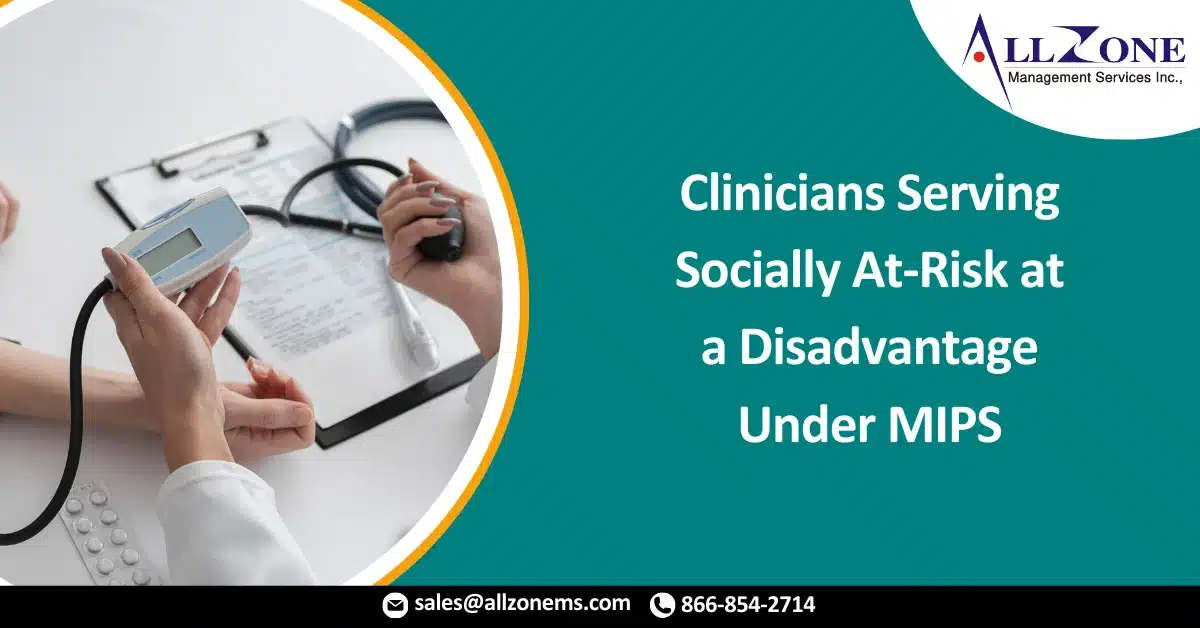Clinicians who served more patients with social risk factors such as low income performed worse in the Merit-Based Incentive Payment System’s inaugural payment year, and therefore, received unfavorable value-based reimbursement, according to a new study.
The study recently published in Health Affairs found that out of 510,020 clinicians participating in the Merit-Based Incentive Payment System (MIPS) in 2019, those with high social-risk caseloads had 13.4 points lower performance scores and were 99 percent more likely to receive a negative payment adjustment.
The clinicians were also 52 percent less likely to receive an exceptional performance bonus payment compared to MIPS clinicians with the lowest social at-risk caseloads.
“Our findings extend prior evidence that has shown that value-based payment programs disproportionately penalize health care providers who care for socially at-risk populations,” wrote the researchers from Saint Louis University, Emory University, and Brigham and Women’s Hospital.
According to prior studies, clinicians who largely serve patients with social risk factors have tended to fare worse than their peers in value-based reimbursement programs, including the Medicare Value-Based Modifier Program, which was rolled into MIPS.
But differences in value-based reimbursement performance between clinicians with different social-risk caseloads do not stem from quality of care, the latest study indicated.
Researchers examined the top 20 publicly reported individual MIPS performance measures in 2019 and found that clinicians with high social-risk caseloads outperformed their peers on key quality measures, such as post-discharge medication reconciliation and use of care plans, although performance by social-risk caseload was more mixed across these types of measures.
The clinicians, however, performed significantly worse than their peers on technology-dependent process measures, including secure messaging or participation in health information exchange.
“Practices that treat more socially at-risk patients may lack the technological resources and practice infrastructure to successfully meet value-based payment reporting requirements and perform poorly as a result,” researchers explained.
This issue is particularly salient in MIPS, researchers added, because clinicians can self-select measures to report on for overall performance scores.
“Resource-poor clinics and practices might not have the financial ability to hire staff familiar with the electronic data upload processes or might not have data infrastructure that facilitates quality measurement,” they wrote.
As MIPS matures, CMS is working to address the problem for clinicians serving more socially at-risk patients. In the 2021 performance period, for example, the agency is implementing a Complex Patient Bonus to MIPS, which will add five points to a clinician’s final MIPS performance score based on the medical complexity of their patients and the proportion of socially at-risk patients treated based on historical performance data.
The bonus is a step in the right direction, industry stakeholders have said, but it may not be enough to successfully stop MIPS from disproportionately penalizing clinicians who care for socially at-risk patient populations.
According to the study in Health Affairs, if qualifying clinicians received the Complex Patient Bonus in 2019, it would have increased MIPS performance scores and the likelihood of receiving exceptional performance bonus payments by just 4.7 percent and 2.8 percent, respectively.
The bonus also would have done nothing to reduce the proportion of clinicians with disproportionate numbers of socially at-risk patients receiving negative payment adjustments.
“Clinicians who received negative adjustments in 2019 did so because they did not successfully report MIPS performance measures to CMS. Such clinicians are not eligible for the Complex Patient Bonus,” researchers explained.
The findings suggest a new approach to social risk adjustment in value-based reimbursement programs such as MIPS, the study concluded.
“If risk adjustment fails to account for differences in the underlying patient populations and their environments that influence performance on these measures, MIPS will continue to penalize clinicians serving the neediest populations rather than those who deliver poor-quality care,” it stated.
CMS could consider comparing physicians within the same category of patient social risk, researchers from Weill Cornell Medical College recently suggested in a study.
Their study published in JAMA earlier this week found that physicians with the highest proportion of patients dually eligible for Medicare and Medicaid had significantly lower MIPS scores compared with physicians with the lowest proportion.
Similar to the Health Affairs study, their findings also suggested that the Complex Patient Bonus would not be enough to support practices serving high proportions of medically and socially complex patients.
For More Information: https://revcycleintelligence.com/news/clinicians-serving-socially-at-risk-at-a-disadvantage-under-mips

